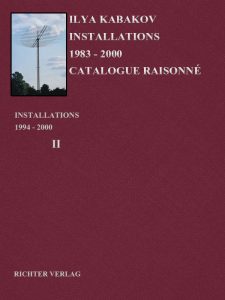The Meeting:
with Jan Fabre
YEAR: 1998
CATALOG NUMBER: 116
PROVENANCE
The artist
Collection Deweer Art Gallery, Otegem
EXHIBITIONS
Otegem, Deweer Art Gallery
‘Een Ontmoeting/Vstrecha’ (The Meeting) Jan Fabre & Ilya Kabakov, 31 Jan 1998 — 15 Mar 1998
Diepenheim, Rozenboomkammer
28 Feb 1999 — 14 Mar 1999 (Organization: Kunstvereiniging Diepenheim, Diepenheim)
Bolzano, AR/GE Kunst Galerie Museum
9 Jul 1999 — 4 Sep 1999
Vienna, Kunsthalle Wien
Get together. Kunst als Teamwork, 8 Oct 1999 — 9 Jan 2000
DESCRIPTION
In the middle of a large hall on the floor lies a large crate – or more accurately, a frame made of boards – that is 6 x 7 meters, into which has been poured a rather large heap of dirt. It is as though this entire heap of dirt represents a battlefield: ‘soldiers’ and ‘officers’ dressed in various uniforms – green, brown, gray, red – are moving in regiments in various directions. All of these regiments and detachments consist of beetles of different types, shapes, and color. Above this ‘battlefield’ hangs a whole swarm of flies – around 600 of them – moreover, they are arranged not chaotically, but rather in a very intentional pattern resembling either a large, broad vessel or some sort of oddly shaped cupola. Everything taken together forms strange, mysterious events on the ‘ground’ and in the ‘air’ by insects that are connected to one another: flies and beetles are two of the most ancient and resilient types of insects on our planet.
CONCEPT OF THE INSTALLATION
This installation is the last in a series of joint works with Jan Fabre. The first of them was the joint dialogue in Tokyo in the opera house, where each of us spoke in our own language: Jan in Flemish and I in Russian, and the Japanese were surprised that we could understand one another. Then there was the joint film that we made in New York in 1997 on the roof and in the basement of a building downtown in Tribeca. Then, the next year, we made this joint installation.
During our very first meeting, having decided to do something together, we started to look for both a form and a theme for our ‘collaboration.’ But it wasn’t hard to find such a theme: a very large number of the works, sculptures, and objects made by Jan Fabre use beetles (obviously, preserved ones). Jan Fabre’s interest in insects is a family affair, one might say – his grandfather was a great entomologist whose books I knew about even when I was living in Moscow. Jan was also familiar with my constant interest in flies. We decided immediately that I would represent the fly world, that is, I would become a fly and Jan Fabre would become a beetle. This served as the plot and main script for our film. Jan made two costumes – a fly and a beetle – and we first staged an improvisational performance in them in the dark basement of the building in which the beetle has a conversation with the fly about art, history, etc. Moreover, of course, both insects expressed different views, each from its own perspective, about the problems of human civilization. The second part of the film was shot on the roof of the same building, from which there was a great view of Manhattan, and the fly and the beetle looked like they were hovering above the New York skyscrapers. We continued the dialogue here. At the end of the film, the beetle and the fly ascend into the air and abandon the earth, or more precisely, the roof where they had landed for just a while.
The installation, Flies and Beetles, was built a year later in the Deweer Gallery in Belgium. Here we used and played with the theme of ‘earth and sky’ since it seems to us that the world of the earth belongs to beetles (even though, like all beetles, they can fly), and the sky, naturally, belongs to flies (even though flies are capable of walking around on the ground). So dirt was poured into an enormous flat crate and represented a field of battle: it was impossible to understand who was fighting with whom from the movements and positions of the regiments – only the military leaders-beetles knew this ‘secret.’ The flies revolved above this field of battle in multi-layered circles, or they simply conducted disinterested observations, or they undertook mysterious management – and there was no way of learning about this either.
There is yet one other quality of this installation with flies and beetles. When there turned out to be such a multitude of both of these (the flies, of course, were artificial, plastic), 600 flies formed a fly pyramid; the beetles, in my opinion, no less in number, created an unexpected optical effect of perpetual motion, moving rather slowly and calmly, but still moving, as though this was all happening before our very eyes. Where this effect came from is difficult to say, but every viewer who stood near the installation spoke of it. This installation did not create the impression of an ethnographic exhibit at all, like the exhibit of ant culture in the museum. Perhaps this is because the beetles down below were organized in strange military orders, and the flies up above seemed to be revolving in circles (while remaining immobile) – imparting a strange impression of a mysterious movement, a strange theatrical show of organized ensembles without soloists.
Images
Literature




